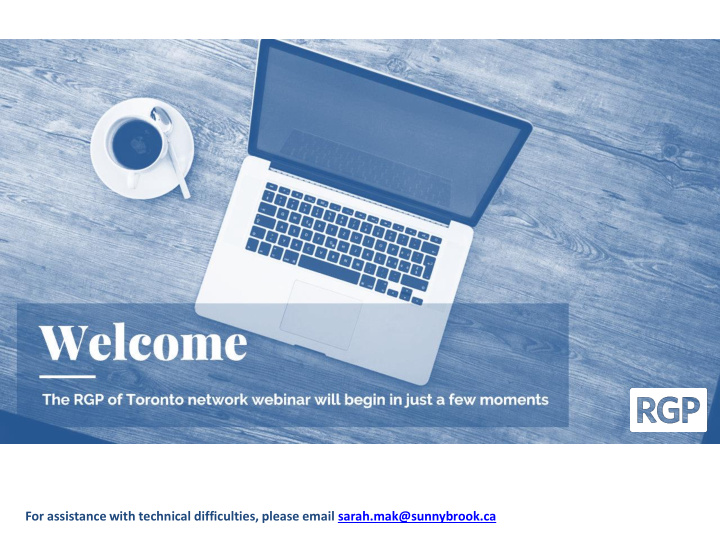



For assistance with technical difficulties, please email sarah.mak@sunnybrook.ca
For assistance with technical difficulties, please email sarah.mak@sunnybrook.ca
For assistance with technical difficulties, please email sarah.mak@sunnybrook.ca
Vir irtua tual l Car Care e Webina binar r Se Series ries Today’s Topic To ic Par art t 1: Int 1: Introdu oduct ction ion to to Senior Senior Friendl riendly y Vir irtual C tual Car are Janice Baker, MA, PhD Alekhya Johnson, MPH Dr. Barbara Liu, M.D., Caitlin Brandon, MSc FRCP(C), FRCP (Edin)
Today’s Disc Disclosu losures es & & To Topic ic Confli Conflicts cts of of I Inte nterest est We receive funding from a variety of sources including the Toronto Region and Central Region of Ontario Health, and the Canadian Frailty Network. Dr. Barbara Liu has received an honorarium from Saint Elizabeth Health
Le Lear arning ning Objectiv Objectives es Today’s To Topic ic Par art t 1: Int 1: Introdu oduct ction ion to to Senior Senior Friendl riendly y Vir irtual C tual Car are At the end of this webinar, you will be able to do the following: • Describe key recommendations for senior friendly virtual care. • Describe a 5 step algorithm for how to triage seniors for virtual care. • Use user-friendly digital tools for virtual cognitive assessments.
Vir irtua tual l Fir First st SGS SGS Mod Model of el of Ca Care This model outlines the steps to determine when and how a patient referred to Specialized Geriatric Services (SGS) can be seen for an initial assessment by a member of the interprofessional team. Opportunity for a collaborative ‘one - team’ approach between available ambulatory services Decision-making process for seeing patients preferably by virtual means Virtual-first has been necessitated by COVID-19, but will continue to play a key role in care long after the pandemic The initial assessment can be performed by most members of the interprofessional team The initial assessment includes: The core elements of the CGA Initial recommendations Streams the patient to the most appropriate next step, which may include the following services: Geriatric Clinic Day Hospital Outreach Geriatric Psychiatry - Complex issue(s) - medically stable who - home-bound - main concerns involve requiring in-person require intervention - require home psychiatric, cognitive specialist assessment to improve function assessment or behaviour issues
Vir irtua tual l Fir First st SGS SGS Mod Model of el of Ca Care STEPS: 1. VERIFY REFERRAL IS NEEDED: Connect with referral source to ensure referral is still required. Pre-review in Connecting Ontario. Include a COVID screen . 2. DETERMINE URGENCY: Determine urgency based on the following criteria: Are any of the following present? Stream to be YES Lives alone / no family or friend support seen within 2 Acute decline in cognition/ functional/mental health weeks Multiple ED visits / recent ED or hospital discharge Stream to Significant or disabling distress (patient, caregivers) NO wait list
Vir irtua tual l Fir First st SGS SGS Mod Model of el of Ca Care 3. DETERMINE MODE OF INITIAL ASSESSMENT: Begin steps to book first assessment appointment based on urgency determination. Book video YES A. Does the patient have access to the appropriate technology appointment to connect by video, and are they comfortable using that technology? If not, is there an organizational technology kit NO See Step B that could be delivered to the patient? B. Are any of the following individuals available to attend the Book video YES appointment with the patient, who have access to and know appointment how to use the technology? NO See Step C • Family / friend / caregiver • Other health care provider Book phone YES C. Does the patient have the ability (e.g. cognitive capacity) appointment to do an initial assessment by phone? Does the patient have Book a phone plan that makes this type of visit economically NO in-Person feasible? appointment
Vir irtua tual l Fir First st SGS SGS Mod Model of el of Ca Care WAITLIST MITIGATION: Lengthy waitlists may be detrimental to the health of a patient and/or their caregiver. Using community connections and partnerships, provide alternative linkages and/or supports such as the following, based on the most pressing referral issues: • Community services, primary health care provider , OHT partners, or Care of the Elderly physician • Connect with primary care provider/referral source to offer advice on management, navigation for patient, facilitate needed supports • Provision of instructions on who best to contact if there is a change in the patient’s status (beyond an emergency situation)
Vir irtua tual l Car Care e Q&A Q&A
Ques Questions fr tions from om the the cha hatbo tbox?
16 www.rgptoronto.ca
RGP Virtual Care Webinar Series Part 2 November 6 th , 2020 RGP Virtual Care Webinar Series Part 3 December 4 th , 2020 Topics will include: • How to build trust in a virtual care setting • How to set up and execute an effective virtual visit • How to gather and pre-package data from Connecting Ontario For questions, please email sarah.mak@sunnybrook.ca 17 www.rgptoronto.ca
Recommend
More recommend